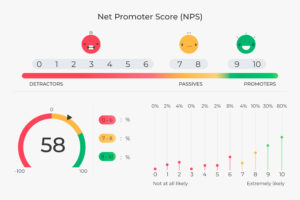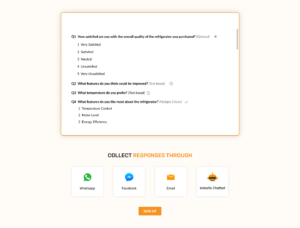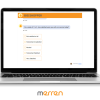Customer acquisition is expensive. It is said that it is six times more expensive to win a new customer than to retain an old one. As a result, companies are constantly searching for ways to improve customer loyalty and retention.
Businesses that prioritize satisfaction and retention are more likely to succeed in the long run. One effective method for achieving this is building an omnichannel customer satisfaction engine.
In this blog post, we will delve into the importance of omnichannel surveys in building brand loyalty and discuss the key benefits of using them to improve customer experience. We will also provide strategies for implementing omnichannel surveys, types of surveys you can use, and best practices for conducting successful surveys. Additionally, we will cover tools for implementing an omnichannel survey strategy and how to analyze and act on the data collected. With these insights, you can build an effective omnichannel customer satisfaction engine that can help you meet customer expectations and achieve better customer loyalty and retention.
What Are Omnichannel Surveys?
Omnichannel surveys are a method of collecting customer feedback across multiple channels and touchpoints. These surveys can be conducted via email, SMS, messaging apps, emails, social media, or through website chatbots and in-app surveys.
Many organizations rely on one or two channels to measure and optimize their interactions with customers, which limits the accuracy and depth of customer insights.
Omnichannel surveys provide businesses with a deeper understanding of the customer experience (CX) across different touchpoints and enable them to identify pain points in the customer journey. This information can then be used to improve the overall CX and increase customer loyalty and retention. With an effective omnichannel survey strategy in place, businesses can gather valuable insights from their customers and use them to improve their products, services, and overall CX.
Importance of Omnichannel Surveys in Building Brand Loyalty
Maintaining strong brand loyalty is essential for any business looking to succeed in a competitive market. This is where omnichannel surveys come in. By collecting feedback from customers across multiple touchpoints, businesses can obtain a complete picture of customer satisfaction and identify areas for improvement. This allows them to make targeted changes to their products,
services, and overall customer experience, increasing the likelihood of customer loyalty and retention. Consistent use of omnichannel surveys also shows customers that their opinions are valued, building trust and demonstrating a commitment to their satisfaction. Overall, implementing an effective omnichannel survey strategy can set businesses apart from competitors and drive long-term growth.
What is Brand Loyalty and Why is it Important?
Brand loyalty is the extent to which customers consistently choose one brand over others. It is crucial because it leads to repeat business, positive word-of-mouth publicity and increased profits.
Repeat customers are more likely to buy additional products or services and are willing to pay more for them. They also act as brand ambassadors, sharing their positive experiences with others and helping to attract new customers. By building brand loyalty, businesses can establish a strong reputation in the market and create a loyal customer base that drives sustainable growth over time.
It is this power of a loyal customer base that companies invest significantly into loyalty programs. However, simply having a customer loyalty program may not be enough. To truly build brand loyalty, businesses need to understand their needs and preferences, and consistently deliver exceptional experiences across all touchpoints. This is again where omnichannel surveys come in.
Omnichannel surveys can serve as a tool for businesses to understand their customers’ needs and preferences across all channels – online, in-store, mobile, etc. This understanding enables businesses to tailor their products and services to customers’ needs leading to more satisfied customers.
Effective omnichannel surveys should be easy to use, timely, personalized, and provide actionable insights. By leveraging the power of omnichannel surveys, businesses can create a meaningful connection with their customers and foster long-term relationships that drive growth.
The Impact of Omnichannel Surveys on Customer Loyalty
Customers who feel heard and valued are more likely to remain loyal to a brand. By using omnichannel surveys, companies can gain a more comprehensive understanding of the customer
experience and identify areas for improvement. This knowledge can help companies address pain points in the customer journey and improve overall satisfaction. As a result, they are more likely to have positive experiences with the brand, leading to increased loyalty and positive word-of-mouth advertising. Additionally, companies can track changes in customer sentiment over time and adjust their strategies accordingly, ultimately leading to higher retention rates and increased revenue.
Key benefits of using Omnichannel Surveys for Customer Experience (CX)

Introducing an omnichannel survey strategy is the best way to enhance the customer experience and improve brand loyalty. By gathering feedback from multiple touchpoints, businesses can gain a comprehensive understanding of their customers’ needs and preferences. This approach can identify pain points in the customer journey, thereby improving overall satisfaction. Additionally, utilizing multiple channels increases the chances of capturing feedback from a wider audience, allowing businesses to personalize their products and services effectively. As a result, investing in an omnichannel survey strategy can lead to more repeat customers and increased revenue for businesses. Afterall, happy customers are a great way to build a business for the long haul.
Strategies for Implementing Omnichannel Surveys
To implement successful omnichannel surveys, there are several strategies that businesses can utilize. First and foremost, it’s essential to collect feedback from customers across all channels, including email, social media, and in-store. Using a unified platform to manage and analyze this data is also crucial in gaining a holistic view of the customer experience (CX). Personalizing surveys based on the customer’s previous interactions and preferences can increase response rates and improve the overall quality of feedback received. Furthermore, ensuring that surveys are brief and easy to complete can encourage more customers to participate. Finally, leveraging data from omnichannel surveys to make improvements to the overall customer experience is key in increasing loyalty and retention over time.
Identifying the Right Channels for Omnichannel Surveys
To get the most out of your omnichannel surveys, it’s essential to identify the right channels for collecting feedback. While traditional survey methods may have focused solely on email or phone, modern omnichannel surveys offer a range of options, including messaging apps, emails, chatbots and in-app notifications. By understanding your customers’ preferences and behavior, you can ensure that you’re collecting feedback through channels they use and trust. This approach not only increases response rates but also provides a more comprehensive view of the CX. So take the time to analyze customer behavior and identify the channels that will work best for your business.
Read how to go about choosing the right channel for collecting feedback from your customer.
Personalization in Omnichannel Surveys
In today’s hyper-competitive business landscape, personalization has become the buzzword for delivering exceptional customer experiences. The same is true for omnichannel surveys. Personalizing survey questions and follow-up communications according to individual preferences can significantly impact response rates and overall satisfaction levels. By leveraging customer data, businesses can segment their audience and provide targeted messaging that speaks directly to their needs and interests. This not only improves the quality of feedback collected but also enhances brand loyalty by demonstrating a genuine interest in what matters most to customers. Additionally, offering incentives or rewards for completing the survey can further increase participation rates while providing a unique opportunity for businesses to show their appreciation for customer feedback.
Designing Effective Survey Questions for Each Channel
To ensure that omnichannel surveys are effective, designing relevant and well-crafted survey questions for each channel is crucial. The questions should be tailored to the specific platform, taking into account both the audience and their behavior on that particular channel. For instance, social media channels may require shorter and more straightforward questions, while email surveys can have more detailed ones. It’s important to avoid leading or biased questions that may sway results and instead consider using a mix of closed-ended and open-ended questions to gather both
quantitative and qualitative data. Overall, designing effective survey questions leads to collecting relevant feedback, which can drive business growth.
Read how to write a good survey or use of AI Survey Builder get build one in seconds.
Closing the Loop On Customer Feedback Quickly
Closing the loop on customer feedback quickly is equally important as collecting it. It’s essential to follow up with customers who have taken the time to provide their feedback and show them that their opinions matter. Businesses can leverage automation tools to send personalized follow-up communications according to individual preferences, creating a seamless and efficient process. Responding promptly not only demonstrates appreciation for their feedback but also shows a commitment to resolving any issues they may have encountered. Quick responses can go a long way in improving overall satisfaction levels, building long-term customer loyalty and converting them into brand advocates.
Read our blog on how to close the loop on customer feedback quickly
Types of Omnichannel Surveys
When it comes to conducting omnichannel surveys, there are several types to choose from. In-app surveys allow for immediate feedback and insights within your app, while email surveys can be customized to fit the specific needs of your business. Website surveys pop up on your website, giving customers the opportunity to provide real-time feedback, whereas SMS surveys allow them to participate via text message. Social media channels such as Facebook and Twitter also offer platforms for conducting quick and easy customer satisfaction polls. Each type of survey has its advantages and limitations, so it’s important to carefully consider which channels will work best for your business goals and target audience.
WhatsApp and Facebook Messenger surveys

WhatsApp and Facebook Messenger are the two most commonly used messaging platforms in the world. As more businesses start to adopt omnichannel strategies, it’s important to consider using WhatsApp and Facebook Messenger for conducting surveys. These platforms offer a convenient way to engage with customers where they already spend most of their time. With WhatsApp and Facebook Messenger surveys, businesses can gather feedback on their products or services, customer experiences, and preferences.
Messaging apps allow businesses to capture in-moment feedback which can lead to more accurate and relevant insights. These surveys can be designed to be short and sweet, ensuring that respondents don’t feel burdened while offering their feedback. Additionally, these messaging platforms have features like read receipts, which help businesses track customer engagement and response rates.
When it comes to conducting omnichannel surveys, the key is to choose channels that align with your business goals and target audience. WhatsApp and Facebook Messenger surveys offer a unique opportunity to engage with customers in a way that is convenient and non-intrusive. By leveraging the power of messaging apps, businesses can gather both quantitative and qualitative feedback.
One advantage of these messaging platforms is that they allow for personalization and customization of survey questions based on customers’ specific needs. Additionally, since these surveys are conducted within a private chat messaging environment, they may feel more comfortable providing honest feedback and the whole experience feel a lot more conversational.
Email surveys
Email surveys are a popular and effective way to gather customer feedback in an omnichannel approach. They offer a simple and convenient option for them to provide their feedback, which can be easily personalized and automated, making them efficient for large-scale surveys. These surveys can be sent out after a customer service interaction, purchase or at regular intervals to gauge overall satisfaction. Data collected from email surveys can help identify areas for improvement and enhance customer loyalty.
Email surveys are sent out in three formats: Email invitation with a link to a survey, HTML email survey and an AMP survey. The choice of format would depend on your customer base and what format they are most comfortable using.
In-app surveys
In-app surveys provide a convenient way to gather customer feedback in real-time. They are a great tool to collect feedback while the customer is using your mobile app. By targeting users at specific points in their journey, such as after making a purchase or trying out a new feature, businesses can quickly address any issues and improve overall satisfaction. In addition to improving customer experience, in-app surveys can also provide valuable insights into user behavior and preferences, which can inform future product development and marketing efforts. To ensure high response rates, it’s important to keep these surveys short and relevant, tailoring questions to the specific context of the app.
SMS surveys
Like WhatsApp and Facebook Messenger, SMS surveys are a convenient and effective way to gather customer feedback in real-time. With high open rates, SMS surveys offer quick and easy access to them on their mobile devices, making them an ideal method for collecting immediate feedback after a recent interaction with your brand. This allows businesses to quickly identify areas for improvement and take action to address any issues, improving overall customer satisfaction. However, it’s important to keep SMS surveys short and straightforward, with clear questions that are easy to understand, to ensure high response rates. By leveraging the benefits of SMS surveys, businesses can gain valuable insights into customer satisfaction levels and make data-driven improvements to enhance the overall customer experience.
Measuring Brand Advocacy with Omnichannel Surveys
Measuring brand advocacy is essential for understanding customer loyalty and satisfaction levels. Omnichannel surveys allow businesses to collect feedback from customers across multiple channels, providing a comprehensive understanding of the their experience. By tracking brand
advocacy over time using metrics like Net Promoter Score (NPS) or Customer Satisfaction (CSAT) Score, businesses can measure the effectiveness of their customer satisfaction strategies. This data can help identify areas for improvement and make data-driven decisions to enhance overall customer loyalty and retention. Additionally, omnichannel surveys can help businesses identify their most loyal customers, allowing them to ask them for a referral and reward them for their continued patronage.
Net Promoter Score (NPS)

Net Promoter Score (NPS) is a widely used metric for measuring customer loyalty and brand advocacy. It provides businesses with a clear understanding of how likely their customers are to recommend their brand to others. By asking them to rate the likelihood of recommending the brand on a scale of 0-10, NPS helps identify promoters, passives, and detractors.
Calculating NPS involves subtracting the percentage of detractors from the percentage of promoters, which gives businesses an overall score that indicates customer advocacy, a level up on just plain, vanilla loyalty. Collecting NPS data through omnichannel surveys allows businesses to identify areas for improvement and work towards enhancing customer satisfaction and loyalty.
Customer Satisfaction (CSAT) Score
Understanding the level of customer satisfaction is crucial for any business to thrive. CSAT Score is a widely used metric that helps businesses measure how satisfied their customers are with their products or services. By using surveys that ask customers to rate their satisfaction on a scale of 1-5, businesses gain valuable insights into areas where they need to improve. An omnichannel approach to CSAT surveys can help gather data from multiple touchpoints, such as website, social media, and in-store interactions, providing a more comprehensive view of satisfaction. Tracking CSAT over time allows for identifying trends and taking action to improve the customer experience, ultimately leading to increased brand loyalty and retention.
Using Omnichannel Surveys to Improve Customer Retention
In today’s competitive business environment, customer retention is crucial for the success of any brand. Using omnichannel surveys can help businesses gather valuable feedback from customers across multiple touchpoints. The insights gathered can then be used to identify areas for improvement in customer satisfaction and retention. By addressing their concerns and improving overall satisfaction, businesses can increase customer loyalty and retention.
Additionally, an omnichannel approach ensures that all customers have an opportunity to provide feedback, regardless of their preferred communication channel. This leads to a more comprehensive understanding of the customer experience and helps build stronger relationships with them over time.
Understanding Customer Retention
Customer retention is a critical aspect of any business. It’s the ability to maintain customers over time and ensure that they keep choosing your brand, product or service. Understanding customer retention is essential for businesses that want to improve their rate of customer loyalty and retention. With omnichannel surveys, businesses can collect feedback from customers across multiple channels, such as email, social media, and in-store visits, which help them identify areas for improvement in their customer experience. By using this data to tailor their products or services to meet these needs and improve customer satisfaction, businesses can increase customer loyalty and retention.
The Role of Omnichannel Surveys in Customer Retention
Customer retention is crucial for any business looking to maximize revenue and maintain a competitive edge in the market. Omnichannel surveys play a significant role in customer retention by providing businesses with valuable feedback from them across various channels, including email, messaging apps, chatbots, in-app and in-store visits. With omnichannel surveys, businesses can gather insights into customer preferences and needs, enabling them to tailor their products or services accordingly. This information can then be used to improve the overall customer experience, increase satisfaction and ultimately boost loyalty and retention rates. By implementing an effective omnichannel survey strategy, businesses can ensure they are meeting their customers’ expectations and staying ahead of competition.
Best Practices for Conducting Successful Omnichannel Surveys
When implementing omnichannel surveys, there are certain best practices that businesses should keep in mind. One of the most important factors is to use a variety of survey methods to reach customers, such as online, phone, and in-person surveys. This helps to ensure that they can provide feedback in the way that is most convenient for them. Additionally, it is crucial to keep surveys short and focused on specific aspects of the customer experience, as this improves response rates and allows for more actionable insights.
Finally, following up with those who provide feedback is essential, as it shows that their opinions are valued and can help build trust and loyalty over time. By implementing these best practices, businesses can effectively use omnichannel surveys to improve the customer experience and increase retention rates.
Setting clear objectives
To conduct a successful omnichannel survey, it’s essential to set clear objectives and goals. This involves identifying the specific information you want to gather from customers and how you plan to use it. By defining your objectives, you can develop relevant and focused survey questions that will provide valuable insights into your customer satisfaction and loyalty. Additionally, it’s important to consider using different types of surveys, such as email, SMS, or in-app surveys, to reach customers through their preferred channels. Ultimately, setting clear objectives will help ensure that your omnichannel survey provides actionable insights for improving the customer experience.
Timing and Frequency of Surveys
To get the most out of your omnichannel survey strategy, you need to consider the timing and frequency of your surveys carefully. Surveys should be conducted at appropriate intervals, such as after a purchase or interaction with customer support, but not so frequently that customers feel overwhelmed or bombarded by too many survey requests. Striking a balance between collecting valuable feedback and not intruding on the customer’s experience is key. By implementing
omnichannel surveys with consideration for timing and frequency, you can gain valuable insights into your customers’ experience and improve their satisfaction and loyalty.
Following up and taking action on feedback

After collecting customer feedback, it’s crucial to take action on it. Following up with customers shows that you value their opinions and are committed to improving their experience. Take the time to acknowledge the feedback received and thank them for taking the time to provide it. Then, identify any recurring issues or concerns raised by customers and develop solutions to address them. By using omnichannel surveys to collect customer feedback and actively following up on it, you can improve customer satisfaction and loyalty while also gaining valuable insights into your business operations.
Tools for Implementing Omnichannel Survey Strategy
Selecting the right tools for implementing an omnichannel survey strategy is key to its success. A survey platform that can integrate with multiple channels, such as email, SMS, and social media, is essential. Additionally, using a customer feedback management system to collect and analyze feedback from various sources can provide valuable insights into customer sentiment. Automation tools can be used to send surveys at the right time and frequency, improving response rates. Finally, utilizing data analytics to gain insights and identify areas for improvement in your customer experience can help drive positive change. By leveraging these tools together, businesses can better understand their customers and take action to improve their experience.
Merren

Merren is a tool build for collecting feedback from the customer wherever they are. It is the only tool that can help generate high survey response rate from both online and offline customer touchpoints. It is a powerful tool that integrates with email, messaging apps like WhatsApp and Facebook Messenger , chatbots, in-app surveys to ensure that you get feedback wherever your customers are.
Merren’s enterprise feedback management system allows for real-time data collection and analysis, making it easy to identify trends and patterns in customer feedback. Integration with the CRM and automated survey triggering ensures that surveys are sent at the right time and frequency, while advanced analytics provides insights into customer sentiment.
By using Merren for your omnichannel survey strategy, you can gain a deeper understanding of your customers’ needs and preferences, as well as identify areas for improvement in your customer experience. This can lead to increased customer satisfaction and loyalty, ultimately driving business growth.
With Merren’s built-in AI survey builder, businesses of all sizes can easily gather and analyze customer feedback across multiple touchpoints. Start using Merren today to improve your omnichannel survey strategy and enhance your overall customer experience.
SurveyMonkey (Now Momentive)
When it comes to conducting omnichannel surveys, SurveyMonkey is a useful tool for businesses of all sizes. This online survey platform offers various question types and customization options to create tailor-made surveys that fit your business needs. With real-time analytics and reporting, you can easily track and analyze customer feedback, enabling you to make data-driven decisions that improve overall customer loyalty and retention. Survey Monkey’s integration with other tools like Salesforce and Hubspot makes it an excellent choice for companies that are looking to streamline their data collection and analysis processes.
However, SurveyMonkey is not truly an omnichannel survey platform and may not provide a seamless experience across all customer touchpoints. If you’re looking for a more comprehensive and integrated solution, consider using Merren instead.
Qualtrics
When it comes to implementing an omnichannel survey strategy, Qualtrics is a powerful tool for gathering and analyzing customer feedback. The cloud-based software allows businesses to create surveys across multiple channels such as email, SMS, web, social media, and mobile apps. With Qualtrics, companies can take advantage of advanced analytics tools to gain valuable insights into customer sentiment and identify areas for improvement. Real-time dashboard reporting also makes it easy to track satisfaction metrics and monitor the success of your omnichannel survey strategy. Incorporating Qualtrics into your survey strategy can help you improve overall customer loyalty and retention through effective feedback collection and analysis.
Like SurveyMonkey, Qualtrics have some multichannel components and is not truly omnichannel.
Google Forms
Google Forms is an excellent tool for businesses looking to collect feedback from customers through surveys. It offers a simple and easy-to-use platform that allows you to create surveys and collect data across various channels like email, social media, and your website. With a range of question types available, including multiple-choice, text input, and rating scales, you can customize the design of your survey to match your brand’s style. Plus, Google Forms provides real-time analytics that allow you to track responses and identify trends in customer feedback.
While it is restrictive and not omnichannel, using Google Forms as part of your omnichannel survey strategy can help getting started with surveys for customer loyalty and retention by gathering valuable insights into customer satisfaction. Importantly, it is a free tool, so it allows you test out your processes and strategies before you are ready to upgrade to truly omnichannel survey platforms.
How to Analyze and Act on the Survey Data Collected
Data analysis is a critical step in surveying, and it goes beyond just gathering information from customers. Analyzing the data helps businesses to identify trends, key areas of satisfaction, and common complaints among their customers. With this information, it becomes easier to prioritize action items based on pressing customer needs. Additionally, by developing a well-planned action plan with specific steps and timelines, businesses can address customer feedback and improve satisfaction continuously. By doing so, they can retain current customers while also attracting new ones through positive word-of-mouth reviews.
Using Analytics to Draw Insights from the Data
Analytics tools play a crucial role in drawing insights from the data collected through omnichannel surveys. Segmentation of data by customer demographics and purchase history can provide deeper insights. Key metrics such as Net Promoter Score (NPS) and Customer Effort Score (CES) can be used to measure customer satisfaction.
Sentiment analysis can help understand customer perceptions towards specific aspects of your business, such as product quality or customer service. Insights gained from analytics helps businesses create actionable strategies for improving customer loyalty and retention.
Analytics is useful when it leads to actionable insights. With the rise of omnichannel surveys, businesses now have access to an abundance of customer feedback data. However, simply collecting and storing data is not enough. It’s vital to analyze the data and act on it in a timely manner.
To effectively analyze survey data, businesses need to segment it by demographics and purchase history. This can provide deeper insights into specific areas of satisfaction and common complaints. Metrics such as NPS and CES can then be used to measure customer satisfaction and help prioritize action items based on pressing customer needs.
Closing the Feedback Loop by Making Improvements Based on Insights
In order to improve customer loyalty and retention, it is crucial to close the feedback loop by making improvements based on insights. This means taking action on the survey data collected from customers and analyzing their feedback to identify areas where improvements are needed in your business. It is equally important to communicate the action taken to customers, showing them that their feedback has been heard and valued. This helps build an emotional connection and rapport with the existing customer and a great way to win them over with great customer service.
Read more about closing the feedback loop quickly
Conclusion
Omnichannel surveys play a crucial role in building brand loyalty and improving customer retention. By implementing omnichannel surveys, you can gain valuable insights into customer experience and satisfaction across various touchpoints. This data can be used to make improvements and personalized interactions with customers, ultimately leading to increased brand advocacy and customer loyalty. To learn more about how to build an effective omnichannel survey strategy, read our comprehensive guide on best practices, tools, and techniques. Don’t miss out on the opportunity to improve your customer satisfaction engine. Start implementing omnichannel surveys today!





